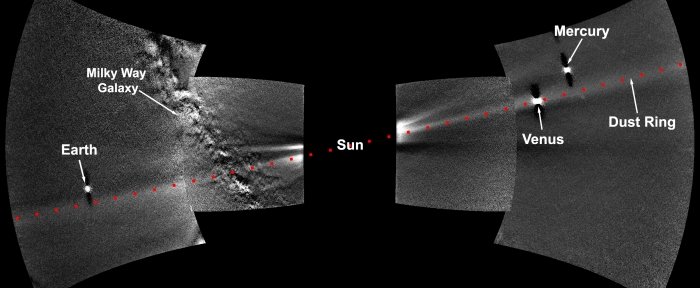A wispy ring of dust that circles the Sun along the orbital path of Venus has just been revealed in the most detail yet, thanks to instruments carried by the Parker Solar Probe.
The pristine, white-light images, taken from inside the orbit of Venus, show the ring in almost its entirety. This is vital data for understanding this ring, and the dynamics of the Solar System and its gravitational interactions.
“This is the first time that a circumsolar dust ring in the inner Solar System could be revealed in its full glory in ‘white light’ images,” said astronomer Guillermo Stenborg of the US Naval Research Laboratory. “I find that pretty special.”

The Solar System is a truly dusty place. The whole thing formed from dust (and gas); much of the dust got integrated into planets and asteroids and whatnot (not to mention the Sun); often it gets shaken back out again.
Asteroids and comets are like cosmic salt and pepper shakers, sprinkling their surrounding space wherever they go. Recent research found that Mars could be spraying the stuff everywhere during the huge, global storms that occur every year.
All that dust can just drift around, but sometimes it can get snatched up in orbital resonance with a planet; that is, it orbits along the same path, with an orbital period that’s a single-integer ratio with that of the planet.
Earth has a significant resonance dust ring; scientists recently found evidence that Mercury has one, too. And Venus’s dust ring has been known, and even partially observed, by joint German-American solar mission Helios and NASA’s solar mission STEREO, for some time.
Cue the Parker Solar Probe, equipped with an instrument called the Wide-field Imager for Solar Probe (WISPR). WISPR consists of two visible-light heliospheric imagers designed to image the interplanetary medium to study the solar wind – the constant stream of charged particles emanating from the Sun.
Because interplanetary dust is so bright with reflected sunlight, it outshines the solar wind, so special image processing is applied to remove the background noise in solar wind observations. This also means that WISPR is uniquely capable to observe Venus’s resonance dust ring.
During normal operations, of course, the dust ring would be automatically extracted from the data. Parker performed some rolling maneuvers in August and September of 2019 to manage its momentum, which caused the WISPR cameras to move – and a bright streak to appear in the resulting images.
At first, the astronomers thought it was something else, such as a glowing helmet streamer shooting out of an active region of the Sun, or even an image processing error. It was way too big to be a helmet streamer, and image processing oopsies were also ruled out. Next step was looking at what else is in that space, and that’s when they found that the streak lined up perfectly with Venus’s orbit.
Since the glow is also consistent with the scattering of light by dust, the team concluded that the most likely explanation is the resonance dust ring of the planet.
The data could be extremely useful. Scientists think that interplanetary dust could be a transport mechanism for molecules within the Solar System, a means whereby materials shed from asteroids or comets make their way to other bodies.
We still don’t know how these dust rings formed, or where they came from, though, so the more information we have, the closer we can get to figuring it out.
“One idea is that the dust rings naturally formed from the primordial cloud, but several researchers contend that each planet’s gravity has gradually trapped the particles, perhaps even asteroid or cometary particles within its orbit,” explained astrophysicist Russell Howard of the US Naval Research Laboratory.
Another possibility is that the dust rings are constantly being turned over; collisions between grains could kick some of the old dust out of orbit, while new dust arrives from elsewhere.
There’s another mystery with the Venus ring, too. Analysis of the data from previous observations suggested there was a lot more dust in Venus’s resonance ring than could be easily explained. A research team recently conducted some modeling, and determined that the best explanation for the quantity of dust is a group of unseen asteroids sharing the orbit of Venus.
We still haven’t found those asteroids, so that hypothesis is far from being confirmed. Who knows, maybe Parker will spot them; or maybe the probe will lead us to another explanation for the phenomenon. Either way, it’s going to be exciting.
“We’re learning things about the dynamics, the exchanges, of dust particles throughout the heliosphere that before Parker Solar Probe we didn’t know,” Stenborg said.
The research has been published in The Astrophysical Journal.



